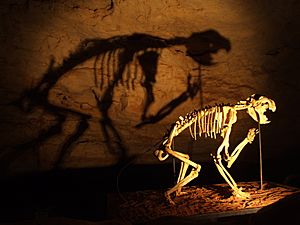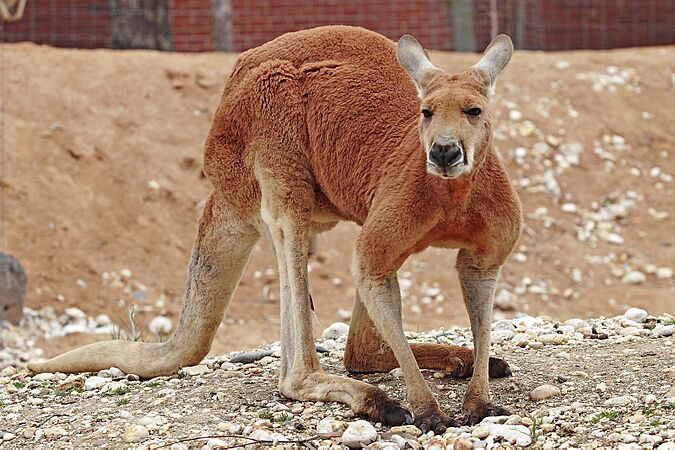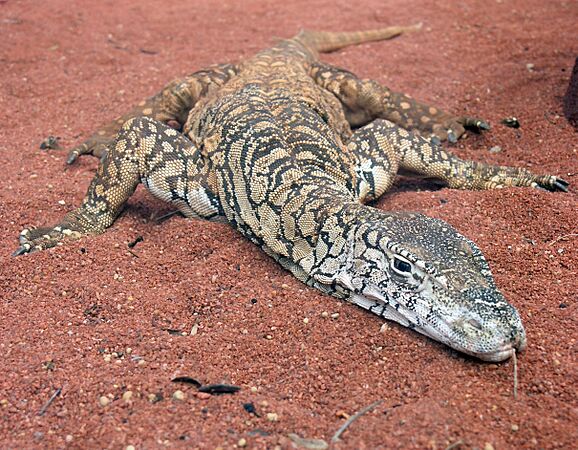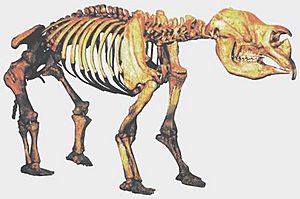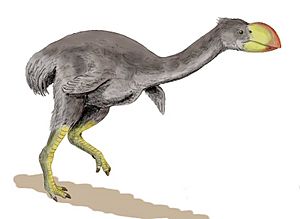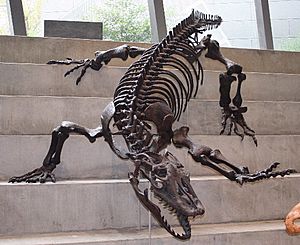Australian megafauna facts for kids
Australian megafauna refers to a group of really big animals that used to live in Australia. These animals were much larger than their closest living relatives today. They died out during the Pleistocene epoch, which was a long time ago, between 16,100 and 50,000 years ago. Scientists have only recently figured out exactly when they disappeared.
Some stories from the Aboriginal Dreamtime describe creatures that sound a lot like these giant prehistoric animals.
Contents
Why Did They Disappear?
Scientists have been trying to figure out why these huge animals disappeared. There are two main ideas:
- Humans: One idea is that when people first arrived in Australia (about 48,000 to 60,000 years ago), they hunted these animals. They also used fire to clear land, which changed the types of plants growing there.
- Climate Change: Another idea is that the climate became much drier during an Ice Age about 18,000 years ago. This change in weather might have made it hard for the megafauna to find enough food and water.
New evidence, using modern dating methods, suggests that humans were the main reason for the extinction. The dates show that most megafauna died out around 47,000 years ago. This was about the same time humans first arrived in Australia.
Scientists believe that human use of fire changed the plants. Many plants could not survive regular fires, so the landscape changed. Studies of megafauna teeth show sudden changes in their diet and the plants they ate. This happened even though the climate was similar to today's dry climate, which the megafauna could handle.
Living Australian Megafauna
Some large animals still live in Australia today:
-
Red Kangaroo.
Extinct Australian Megafauna: Before 1788
Here is a list of some of the amazing Australian megafauna that are now extinct. It includes their scientific name, common name, and a short description.
- Scientific Name, (Common Name, when it lived), and a brief description.
Mammals
Mammals are listed by their size, with the largest at the top.
1000-2000 kilograms
- Diprotodon optatum was the biggest type of Diprotodontid. It was about three meters long and two meters tall at the shoulder. It weighed up to two tonnes, like a giant wombat. It is the largest marsupial ever known.
- Diprotodon minor
- Zygomaturus trilobus was smaller, about the size of a cow. It was two meters long and one meter high. This Diprotodontid might have had a short trunk, like an elephant. It probably lived in wet areas, digging up reeds for food with its two fork-like teeth.
- Palorchestes azael (the Marsupial Tapir) was a Diprotodontoid. It was about the same size as the Zygomaturus, with long claws and a long trunk. It lived during the Pleistocene epoch.
100-1000 kilograms
- Euowenia grata
- Nototherium mitchelli
- Euryzygoma dunense
- Phascolonus gigas
- Ramsayia magna
- Procoptodon goliah (the Giant Short-faced Kangaroo) was the largest kangaroo ever. It grew 2–3 meters (7–10 feet) tall and weighed up to 230 kilograms. It had a flat face and strong teeth to chew tough desert plants. Its eyes faced forward, giving it 3D vision.
- Procoptodon rapha, P. pusio and P. texasensis
- Protemnodon was a type of giant wallaby with four different species.
- Palorchestes parvus
- Macropus pearsoni and M. ferragus
10-100 kilograms
- Simosthenurus pales
- Sthenurus tindalei and S. atlas
- Phascolarctos stirtoni was a koala similar to modern ones, but one third larger.
- Phascolomys medius
- Lasiorhinus angustioens
- Congruus congruus was a wallaby found near Naracoorte.
- Troposodon minor
- Sthenurus oreas
- Simosthenurus occidentalis (another Sthenurine) was as tall as a modern Eastern Grey Kangaroo, but much stronger. It was a leaf-eating kangaroo.
- Simothenurus brownei
- Propleopus oscillans (the Carnivorous Kangaroo) was a large rat kangaroo. It weighed up to 70 kilograms (154 lb). It had strong teeth for cutting and grinding, showing it ate insects, other animals (maybe dead ones), fruits, and soft leaves. It grew to about 1.5 to 3 meters (5 to 10 feet) tall.
- Simothenurus maddocki
- Sthenurus andersoni
- Thylacoleo carnifex (the Marsupial Lion) was the size of a leopard. It had a cat-like skull with big slicing teeth. It had a thumb-claw that could be pulled back, and very strong front legs. It ate meat and lived in trees.
- Vombatus hacketti
- Macropus thor
- Macropus piltonensis
- Zaglossus hacketti was an echidna the size of a sheep. It was found in Mammoth Cave in Western Australia. It is the largest monotreme (egg-laying mammal) found so far.
- Macropus rama
- Simothenurus gilli
- Warrendja wakefieldi was a wombat from Naracoorte.
- Zaglossis ramsayi
- Sarcophilus harrisii laniarius was a large type of the Tasmanian Devil.
- Megalibgwilia ramsayi was a large, long-beaked echidna. It had powerful front legs for digging. It likely ate worms and grubs, not ants.
Birds
- Family Dromornithidae: This group of birds was related to waterfowl (ducks), not modern ratites (like emus and cassowaries).
- Dromornis stirtoni (Stirton's Thunder Bird, Miocene epoch) was a bird that could not fly. It was 3 meters (10 feet) tall and weighed about 500 kilograms (1,100 lb). It is one of the largest birds ever found. It lived in warm, open woodlands and may have eaten meat.
- Bullockornis planei (the 'Demon Duck of Doom') was another large Dromornithid. It was up to 2.5 meters (8 feet) tall and weighed up to 250 kilograms (550 lb). It was probably a meat-eater.
- Genyornis newtoni (the Mihirung) was related to Dromornis. It was about the height of an ostrich. It was the last Dromornithid to survive. It had a large lower jaw and probably ate both plants and animals.
- Leipoa gallinacea (formerly Progura) was a giant malleefowl.
Reptiles
- Varanus priscus (formerly Megalania prisca) was a giant, meat-eating goanna. It might have grown as long as 7 meters (23 feet) and weighed up to 1940 kilograms (4,277 lb).
- Wonambi naracoortensis was a snake about 6 meters (20 feet) long. It would catch animals near water holes and kill them by crushing them. It was not a poisonous snake.
- Quinkana sp. was a land crocodile. It grew up to 7 meters (23 feet) long. It had long legs under its body and chased down mammals, birds, and other reptiles for food. Its teeth were sharp for cutting, unlike the pointed teeth of water crocodiles.
- Liasis sp. (Bluff Downs Giant Python) lived during the Pliocene epoch. It grew up to 10 meters (33 feet) long and is the largest Australian snake known. It hunted mammals, birds, and reptiles in woodlands near rivers. It is similar to the Olive Python (Liasis olivacea).
- Meiolania was a group of huge land turtles. They measured 2.5 meters (8 feet) long and had a horned head and a spiked tail.
Images for kids
See also
 In Spanish: Megafauna australiana para niños
In Spanish: Megafauna australiana para niños


